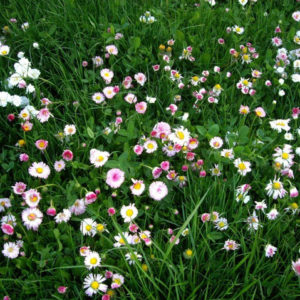Amy Cox, Co-Owner of Pro Time Lawn Seed, discusses low-input, low maintenance alternatives to the conventional, uniform lawn.
The American lawn is changing. Whether driven by environmental awareness or personal taste, homeowners search for sustainable alternatives to the thirsty monoculture of the ‘perfect’ lawn that requires loads of time, fertilizers, and pesticides to maintain. By contrast, an eco-lawn creates a beautiful greenspace while contributing valuable benefits to the environment.
Clover, the backbone to all self-fertilizing eco-lawns, naturally fixes nitrogen in the soil and feeds itself and other companion plants. With this optimal feeding, eco-lawns form a dense, thick stand–the best natural defense against weeds. Whereas weeds in conventional monoculture lawns look obviously out of place, the diversity of species in eco-lawns tends to disguise the occasional weed or even make it look intentional. These are perfect lawns for those who want to go pesticide-free.
We did not always consider clover a lawn weed. Clover was an important component in fine lawns more than 50 years ago—and for good reason. This nitrogen fixing legume is drought-tolerant, virtually immune to diseases, and distasteful to common turf insects. Bees and other beneficial pollinators, also, frequent this free fertilizer for turfgrass when allowed to bloom.
Pro Time Lawn Seed has worked to reintroduce clover to lawns for more than 25 years after developing the original flowering ecology lawn seed mix, PT 755 Fleur de Lawn in collaboration with Oregon State University. Due to rising popularity of its eco-lawn mixes, Pro Time now offers more than a dozen eco-lawns and urban meadows that include only high quality seed, naturally bred and selected for drought tolerance, disease resistance, performance, compatibility and beauty—all non-GMO and neonicotinoid-free.
Homeowners can incorporate some eco-lawn seed mixes by over-seeding into existing lawns, but most mixes perform best in an area with little existing vegetation. Some more sustainable options for preparing the site for planting include sod-cutting, sheet mulching, or solarizing. Dethatching an existing lawn creates bare spots for an effective over-seed. Core aeration prior to planting and on an annual maintenance schedule will keep the underlying soil from compacting and allow it to accept occasional deep waterings, which train the roots to go deeper into the soil where they are less vulnerable to changes in temperature and drought.
 In the fall, plant at least 6–8 weeks before the first anticipated hard frost (28 degrees for more than one hour). In the spring, plant after soil temperatures reach 50 degrees or warmer, the temperature required to trigger germination. In general, eco-lawn mixes have a lighter seed application rate than conventional turf grass. If applied too heavily, one species may crowd out another.
In the fall, plant at least 6–8 weeks before the first anticipated hard frost (28 degrees for more than one hour). In the spring, plant after soil temperatures reach 50 degrees or warmer, the temperature required to trigger germination. In general, eco-lawn mixes have a lighter seed application rate than conventional turf grass. If applied too heavily, one species may crowd out another.
Eco-lawns are not instant lawns but are the result of a maturation process that fills in slowly—about 6-8 weeks. A new eco-lawn will fully establish after lasting one winter. Less frequent mowings at taller height will shade the soil surface, help retain moisture, and protect beneficial insects. Most eco-lawns require mowing at heights of three to five inches about once a month.
Check out ptlawnseed.com for more information.

